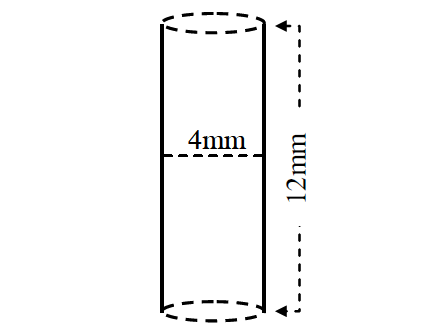THE MEAN VALUE THEOREM WORKSHEET
Subscribe to our ▶️ YouTube channel 🔴 for the latest videos, updates, and tips.
In each case, find the values of c that satisfies the Mean Value Theorem.
Problem 1 :
f(x) = x3, [-2, 2]
Problem 2 :
f(x) = 1 - x2, [0, 3]
Problem 3 :
Problem 4 :
f(x) = 2x3 + x2 - x - 1, [0, 2]
Problem 5 :
Problem 6 :
f(x) = x3 - 5x2 - 3x, [1, 3]
Problem 7 :
A cylindrical hole 4 mm in diameter and 12 mm deep in a metal block is rebored to increase the diameter to 4.12 mm. Using the Mean Value Theorem to estimate the amount of metal removed.
Problem 8 :
Suppose that f(0) = -3 and f'(x) ≤ 5 for all values of x, how large can f(2) possibly be?

Answers
1. Answer :
f(x) = x3, [-2, 2]
(i) f(x) is defined and continuous on [-2, 2].
f(x) = x3
f'(x) = 3x2
(ii) f(x) is differentiable on the interval (-2, 2).
The given function satisfies both the hypotheses of the Mean Value theorem.
Then, we have
2. Answer :
f(x) = 1 - x2, [0, 3]
(i) f(x) is defined and continuous on [0, 3].
f(x) = 1 - x2
f'(x) = -2x
(ii) f(x) is differentiable on (0, 3).
The given function satisfies both the hypotheses of the Mean Value theorem.
Then, we have
3. Answer :
(i) f(x) is defined and continuous on [1, 2].
(ii) f(x) is differentiable on (1, 2).
The given function satisfies both the hypotheses of the Mean Value theorem.
Then, we have
Therefore,
4. Answer :
f(x) = 2x3 + x2 - x - 1, [0, 2]
(i) f(x) is defined and continuous on [0, 2].
f(x) = 2x3 + x2 - x - 1
f'(x) = 6x2 + 2x - 1
(ii) f(x) is differentiable (0, 2).
The given function satisfies both the hypotheses of the Mean Value theorem.
Then, we have
Therefore,
5. Answer :
(i) f(x) is defined and continuous on [-2, 2].
f'(x) is undefined when x = 0 ∈ (-2, 2)
(ii) f(x) is not differentiable on (-2, 2).
The given function does satisfy the second hypothesis of the Mean Value theorem.
So, the Mean Value Theorem does not hold for the given function.
6. Answer :
f(x) = x3 - 5x2 - 3x, [1, 3]
(i) f(x) is defined and continuous on [1, 3].
f(x) = x3 - 5x2 - 3x
f(x) = 3x2 - 10x - 3
(ii) f(x) is differentiable on (1, 3).
The given function satisfies both the hypotheses of the Mean Value theorem.
Then, we have
7. Answer :
Formula to find voilume of a cylinder :
V = πr2h

The volume of cylindrical hole of radius x mm and depth 12 mm is given by
V = f(x) = πx2(12)
f(x) = 12πx2 ----(1)
Since the diameter is increased from 4 mm to 4.12 mm, the restriction we have for the radius x is
2 ≤ x ≤ 2.06 or x ∈ [2, 2.06]
(i) f(x) is defined and continuous on [2, 2.06].
f(x) = 12πx2
f'(x) = 12π(2x)
f'(x) = 24πx
(ii) f(x) is differentiable on (2, 2.06).
We have to estimate the following.
f(2.06) - f(2)
By the Mean Value Theorem, we have
f(2.06) - f(2) = 24πc(0.06)
f(2.06) - f(2) = 1.44πc
Since c ∈ (2, 2.06), we can take c = 2.01.
f(2.06) - f(2) = 1.44π(2.01)
f(2.06) - f(2) = 2.89π cubic mm.
Note :
Any suitable c between 2 and 2.06 other than 2.01 also will give other estimates.
8. Answer :
Since by hypothesis f is differentiable, f is continuous everywhere. We can apply the Mean Value Theorem on the interval [0, 2]. There exist atleast one c ∈ (0, 2) such that
f(2) - f(0) = f'(c)(2 - 0)
f(2) - (-3) = 2f'(c)
f(2) + 3 = 2f'(c)
f(2) = 2f'(c) - 3
Given that f'(x) ≤ 5 for all x. In particular we know that
f'(c) ≤ 5
Multiply both sides by 2.
2f'(c) ≤ 10
Subtract 3 from both sides.
2f'(c) - 3 ≤ 10 - 3
f(2) ≤ 7
Therefor, the largest possible value of f(2) is 7.
Subscribe to our ▶️ YouTube channel 🔴 for the latest videos, updates, and tips.
Kindly mail your feedback to v4formath@gmail.com
We always appreciate your feedback.
©All rights reserved. onlinemath4all.com
Recent Articles
-
SAT Math Practice
Dec 05, 25 04:04 AM
SAT Math Practice - Different Topics - Concept - Formulas - Example problems with step by step explanation -
10 Hard SAT Math Questions (Part - 37)
Dec 03, 25 07:02 AM
10 Hard SAT Math Questions (Part - 37) -
Factorial Problems and Solutions
Dec 02, 25 09:27 AM
Factorial Problems and Solutions

